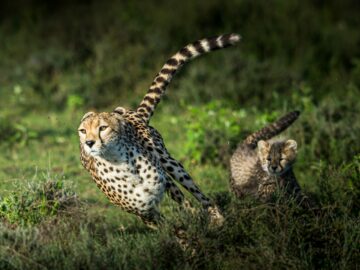You can see them more often in storybooks and animated cartoons, but rhinoceros are really magnificent creatures roaming the lands of Africa and Asia! These mammals are hard to miss, thanks to their attention-catching horns and large builds.
Sadly, due to poaching, rhinos have been classified as extinct. Helping them multiply is not a piece of cake, but we can still do our part in protecting the living rhinos.
If you’re wondering what they are and why they should be protected, here are some quick rhino facts to get you started!
Fun Facts on the Rare Rhinoceros
Seeing rhinos live may be a bit of a challenge, given that they can only be found in the deepest parts of Asia and Africa. But learning about these unique creatures will make you interested in them just the same.
Read up for some unique yet interesting facts on rhinoceros!
Photo by Casey Allen
- There Are Five Rhino Species
Five species of rhinoceros can be found all over the world, especially in Africa. These are the White Rhinoceros, Black Rhinoceros, Sumatran Rhinoceros, Javan Rhinoceros, and Indian Rhinoceros, or the Greater One Horned Rhinoceros.
You would know which are which by looking at their horns. Javan and Indian Rhinoceros have one horn, while the White, Black, and Sumatran Rhinoceros have two.
Do not be deceived by their names! Black Rhinoceros is not black, and White Rhinoceros is not white, either!
Among all these rhinos, it is important to note that the Black, Sumatran, and Javan Rhinoceros are all critically endangered. This means that there is already an extremely high risk of their extinction, and extra precaution is very much needed to keep this from happening.
Help protect rhinos through the International Rhino Foundation!
- Rhinoceros Means Nose And Horn
Some animal names are so unique that you really can’t decipher where they came from, but not for Rhinoceros! It combines the Greek words “rhino” which means nose, and “ceros” which means horn.
Other than rhinos themselves, other animals share the same name. They usually have horn-like structures on their noses. These include the Rhino Shrimp, Rhinoceros Rat Snake, Rhinoceros beetle, and even the Rhinoceros fish!
Photo by Frans van Heerden
- Rhinos Can Get Easily Frightened
It is very rare for rhinos to have predators. Animals who usually hunt young rhinos are adult lions and tigers.
They are born with natural defense mechanisms—thick skin, strong horns, and massive bodies—but they can still get easily threatened! When this happens, they naturally tend to charge against whatever frightens them. Whether this is another animal or an utterly inanimate object, rhinos do not choose!
So, if you ever have the rare chance of seeing a rhino live, be careful not to do anything that can spook these giants.
- Rhinos Prefer To Be Alone
As solitary animals, rhinos are more inclined to avoid each other than stay in groups. But when they do, especially the white rhinos, they are called a “crash.”
When a crash exists, it is usually made up of a mother and her calves. There are also instances when adult female rhinos, called cows, join each other in a crash.
It is very rare to see male rhinos in a crash. Also called bulls, these rhinos only join their kind when searching for mates.
- Territories Are Marked By Rhinos Through Poop
Bulls are known to be highly territorial, and their lands are marked with their poop. This practice is honored across all rhinoceros species, as each of their dung smells unique and can be effectively used to identify individual rhinoceros.
Marking their territories is not hard for rhinos—they can produce up to 50 pounds of dung daily! These are all thanks to the number of plants they consume daily.
- A Rhino’s Weight Is Equivalent to 30 Men
Rhinos look big and heavy, and they are! They are among the largest mammals in the world, with some weighing up to 2,500 kilograms and 1.8 meters tall. This weight is already equivalent to the average weight of 30 adult men combined!
What’s surprising about their weight is their diet. Unlike other substantial land mammals, rhinos don’t prey on other animals. They are herbivores, which means that they only eat plants. That is sure to be tons of plants, though! They eat grass from dusk to dawn!
Watch how rhinos go about their day through All About Rhinos for Kids!
Photo by Saifuddin Ratlamwala
- Rhino Horns Are Made Of Keratin
Rhinoceros’ most prominent feature might be their horns. But did you know these horns are not bones connected to their skulls? Rhinos’ horns are masses of hairs that continuously grow throughout their lifetime. For humans, these are the same as hair and nails!
Their horns are also used by rhinos when digging minerals from the ground. But besides its practical use, rhinos’ horns are known for other reasons. They are made of keratin, the same substance that makes up human hair and nails!
This might also be the reason why rhinos are hunted for their horns. These are believed to have healing powers, but none have been scientifically proven. Hunting rhinos is also against the law, as rhinos are already considered endangered!
- Rhinos Get Pregnant For 15 to 16 Months
It’s not easy for rhinos to reproduce. With 15 to 16 months, they have the second longest gestation period after elephants, who carry their babies for almost two years.
This long gestation period is difficult for female rhinos, as they usually separate from the males after mating. After birth, young calves stay with their mothers for the early years. Since their fathers have already separated from their mothers after mating, there is a huge chance that their fathers will not be part of their social group.
- September 22 is World Rhino Day
There are worldwide calls for awareness of the extinction of rhinos. If you want to join these calls, September 22 is World Rhino Day!
Frequently Asked Questions on Rhinoceros
How aggressive are rhinos?
Rhinos can be easily terrified, but they are not aggressive if not provoked. They usually just roam around alone but can be territorial against other animals. Once threatened, they tend to charge against the perceived threat.
Why is it essential to save rhinos?
Other than being a massive part of history as one of the oldest mammals alive, rhinos also help shape land conservation through grazing. They are agents of balance within the ecosystem!
How are humans helping rhinos?
The current largest threat to the rhinoceros is poaching. There are already several organizations aiming to save the rhinos.
You can visit Helping Rhinos to contribute to protecting the rhinos!







